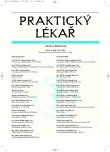-
Medical journals
- Career
Cryptococcal meningitis in a patient with undiagnosed HIV infection
Authors: K. Povolná 1; S. Snopková 1; P. Husa 1; Z. Čermáková 2; M. Freibergerová 1; R. Pařízková 1; M. Šnelerová 1; A. Hajná 1
Authors‘ workplace: Klinika infekčních chorob Lékařské fakulty MU a FN Brno Přednosta: prof. MUDr. Petr Husa, CSc. 1; Klinika biochemie Lékařské fakuty MU a FN Brno Primář: doc. MUDr. Milan Dastych, CSc. 2
Published in: Prakt. Lék. 2008; 88(11): 654-656
Category: Case Report
Overview
Cryptococcus neoformans is an opportunistic pathogen, which affects individuals who are severely immunosuppressed for any number of reasons. Before the introduction of antiretroviral therapy and antimycotic Fluconazole this pathogen had occurred in 10 % of patients with advanced HIV infection. Nowadays, this disease primarily affects patients with so far undiagnosed, thus untreated, severe immunosuppression. The patient outlined here presented with so far undiagnosed HIV infection, nevertheless, patients can be affected following severe induced immunosuppression - particularly following transplantation. The disease is typified by a gradual onset of non-specific symptoms. Often, a headache or a temperature can be the only manifestation of the disease. For this reason, a delay can frequently occur in diagnosing patients with undiagnosed immunosuppression. The diagnosis is verified by confirmation of the pathogen by latex agglutination of cryptococcal capsular antigen and by cultivation. Amphotericin B is the first-choice therapy. Relatively frequent side-effects are the reason for the change of therapy to the less effective Fluconazole. Sensory dysfunction and impaired consciousness are two of the unfavourable prognostic factors that were noticed in the presented patient. The prognosis of the disease is always severe, and in spite of properly introduced therapy, the mortality rate is 10 %. Relapses and the latent survival of the pathogen in the prostate gland are possible.
Key words:
Cryptococcal meningitis, Cryptococcus neoformans, immunosuppression, HIV infection.
Sources
1. Černý, R., Machala, L. Neurologické komplikace HIV/AIDS. 1. vyd. Praha: Karolinum, 2007. 303 s. ISBN 978-80-246-1222-5.
2. Gorbach, S.L., Falagas, M. The 5-minute infectious diseases consult. USA: Lippincott Williams and Wilkins, 2001. ISBN 0-683-30736-3, p. 144-145.
3. Hoffmann, C., Rockstroh, J.K., Kamps, B.S., HIV medicine 2007. 15. ed. Paris: Flying Publisher, 2007. 818 p. ISBN 3-924774-59-5
4. Rozsypal, H. AIDS klinický obraz a léčba. 1. vyd. Praha: Maxdorf, 1998. 236 s. ISBN 80-85800-92-6.
5. Sharkey, P., Graybill, J. Larsen, R. et al. Amphotericin B lipid komplex compared with amphotericin B in the treatment of cryptococcal meningitis in patients with AIDS. Clin. Infect. Dis. 1996, 22, p. 315-321.
6. Singh, C.S., Rahman, M., Jamil, S. et al. Cholecystitis as the initial manifestation of disseminated cryptococcosis. AIDS, 2007, 21, 15, p. 2111-2117. ISSN 0269-9370
7. Snopková, S., Chalupa, P. Postižení plic u infekce HIV/AIDS. In: Záněty plic v intenzivní medicíně. 1.vyd. Praha: Galén, 2004. 189 s. ISBN 80-7262-278-1.
8. Vibhagool, A., Sungkanuparph, S., Mootsikapun, P. et al. Discontinuation of secondary prophylaxis for cryptococcal meningitis in human-imunodeficiency virus - infected patiens treated with highly active antiretroviral therapy: a prospective multicenter, randomized study. Clin. Infect. Dis. 2003, 36, p. 1329-1331.
Labels
General practitioner for children and adolescents General practitioner for adults
Article was published inGeneral Practitioner

2008 Issue 11-
All articles in this issue
- HIV encephalopathy
- Twenty five years since the discovery of the human immunodeficiency virus (HIV)
- Metabolic complications and antiretroviral therapy
- Cerebrovascular complications of HIV infection.
- Problems of viral hepatitis in patients infected with HIV
- New antiretrovirals and the Revised European HIV/AIDS classification
- Current options for active immunization of HIV infected patients
- Pneumocystis pneumonia in a patient with newly diagnosed chronic retroviral infection
- Cryptococcal meningitis in a patient with undiagnosed HIV infection
- General Practitioner
- Journal archive
- Current issue
- Online only
- About the journal
Most read in this issue- Cryptococcal meningitis in a patient with undiagnosed HIV infection
- HIV encephalopathy
- Pneumocystis pneumonia in a patient with newly diagnosed chronic retroviral infection
- Current options for active immunization of HIV infected patients
Login#ADS_BOTTOM_SCRIPTS#Forgotten passwordEnter the email address that you registered with. We will send you instructions on how to set a new password.
- Career

